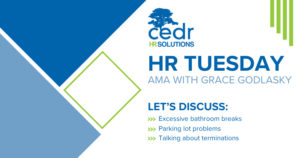Change Your Hiring Best Practices (for Now)

Of the over 12,000 practices that CEDR consults, most of the queries we’re getting right now all revolve around sourcing new hires. The fact of the matter is, all these hiring questions are coming at the exact same time we’ve been in the process of tweaking our usual hiring guidance due to the rapid pace of hiring in the wellness industry. Not only has the demand for CEDR hiring materials… This text opens a new tab to our hiring guide… skyrocketed across all fields, but the demand for dental hygienists, in particular, is growing faster than the national average… This text opens a new tab to an outlook on dental hygienist jobs…. With all this hiring and sourcing happening in the dental field, it might be a good time to look at best practices and issues surrounding hiring in this current job market.
What should I know about hiring right now?
The fact is, right now, any hesitation in the hiring process could cost your practice the most qualified candidate. Conventional wisdom says, “Fire quick, hire slow,” and that’s what we had been telling our CEDR members who called into the Solution Center up until very recently. Lately, however, it’s imperative that employers understand this is a job seeker’s market. If you wait too long to make a decision, the most qualified candidate will probably get snapped up by another practice. That means the old HR best practices may need to temporarily change to adapt to the fast pace of hiring across all healthcare industries.
What can I do to speed up the hiring process?
After recently participating in a panel discussion with some of the top practice managers in the country, the general consensus seems to be that managers really need to get organized before they begin running ads and interviewing so that the actual search goes as quickly and efficiently as possible. While we certainly need to shorten the gap between the interview and the job offer, we still need to be cautious enough to ensure you’re getting the right candidate for your particular practice.
Here are some things you can do to help your practice hire more quickly while still making sure that you’re actually picking the star candidate:
1. Spend a little time getting organized.
The smaller the pool of qualified applicants, the faster the process will go. That means your search should be as specific and narrow as possible if you want the best candidate. In order to do that, you need to get as detailed as possible, spending a little time thinking about the as well as the qualities your next hire should bring to your practice. Even though a little preparation can save you lots of time in the long run.
Some tools that can help you get organized before you begin your job search are the Difference Maker Inventory under the Knowledge Base tab in HR Vault… This text opens a new tab to the HR Vault… and the Difference Maker Tool… This text opens a new tab to our hiring guide… included in CEDR’s Hiring Guide.
The Difference Maker Inventory helps management assess which tasks will need to be part of the new employee’s job description as well as which tasks, if any, can be reassigned to members of the current team. Then, the Difference Maker Tool can be used to pinpoint the qualities that are missing from your current team and add them to the new employee’s job description.
If you spend a little time getting organized and getting purposeful about your search, the right candidate will read your job description, think “This place is perfect for me!” and come directly to you.
2. Begin with professionally crafted job descriptions.
Then, add the customizations you came up with while you were organizing your job search. The reason it’s a good idea to begin with expert-written job descriptions… This text opens a new tab to our job description templates… is that professionally drafted job descriptions already have built-in protections against HR compliance issues which will, of course, save you valuable time during the hiring process.
3. Don’t spend too much time interviewing.
Conduct a first phone interview the moment you spot a qualified candidate. If all goes well, forget about scheduling next week, make an appointment with that candidate tomorrow! In short, don’t give top candidates time to interview at your competitor’s practice.
4. Get background check permission during the interview.
While there are parts of the hiring process you can speed along, the background check should never be skipped. Getting permission to move forward with the background check during the interview can help expedite this process and onboard quickly.
5. Let the potential hire know as soon as you do.
As soon as you’ve identified the best candidate, give them a call. While it is a good idea to be reserved during the interview process, once you’ve decided on a candidate, put those reservations aside! Reach out immediately with the good news, tell them why you were impressed, and make an offer. Don’t bother hiding your enthusiasm. If a candidate is waffling between two nearly equal job offers, they are more likely to lean towards the practice where they feel most wanted and appreciated.
How long should I give a candidate to think about the job offer?
In general, a week is the industry standard. If you’re in a hurry though, you can ask for three days. Any less than that might make the candidate feel rushed and wonder if the day-to-day at your practice will be too unreasonable of a pace. As a rule, if the candidate asks for more than a week to think about it, they probably aren’t too enthusiastic about the position and won’t commit.
Is there anything I can do to prevent a candidate from ghosting?
Ghosting has become a big concern among employers. In fact, 76 percent of employers… This text opens a new tab to an article on employers getting ghosted… say they were ghosted by an applicant this year. The best way to prevent the top candidates from ghosting is by following current hiring best practices– know exactly what you’re looking for and move quickly. Make the time between the second interview and the job offer as brief as possible so a candidate doesn’t get another offer to mull over.
Consider this, though. Ghosting involves a lot of emotional immaturity on the part of the person who’s not responding to communication. Rather than saying, “I’ve changed my mind,” or, “This doesn’t seem like a good fit,” or, “I’m sorry, but I’ve received a better offer,” that person would rather run away from conflict. Ghosting a potential employer indicates that person can’t have hard conversations about difficult issues, and would rather literally hide than do something unpleasant. It’s highly likely that same employee would have trouble admitting to mistakes or bringing important issues to your attention because of their aversion to conflict. If you move through the hiring process quickly and the candidate still ghosts you, maybe you should say, “good riddance.”
Conclusion
If you’re going to hire in 2021, do it as quickly as you can. That doesn’t mean you should be careless or settle for the first warm body that meets the minimum qualifications for the vacant position. On the contrary, it means taking some steps to prepare your hiring materials so you have a smaller, more qualified pool of candidates to choose from. That way, once you’ve identified the ideal candidate, you can make an offer to your star candidate before the competition snaps them up.






